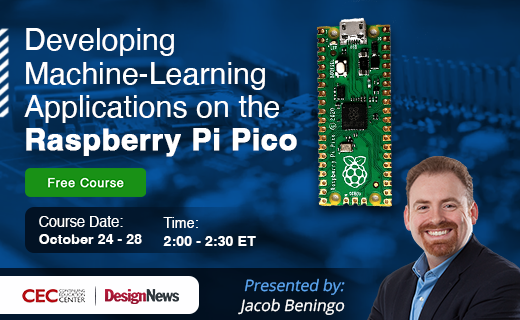The Raspberry Pi Pico is a versatile, low-cost development board that applies to many applications. This course will explore getting up and running with the Raspberry Pi Pico. We’ll mainly focus on how to develop machine-learning applications and deploy them to the Pico. We’ll use gesture detection as an example application. Attendees will walk away understanding machine learning, the Pico, and best practices for working with both.
Registration and Playback are located here (May require login to access)

October 24 – Day 1 – Getting Started with the Raspberry Pi Pico and Machine Learning
In this session, we will introduce the Raspberry Pi Pico development board, based on the low-cost, high-feature RP2040 microcontroller. We will explore the Pico board features and why the board is well suited for machine-learning applications. Attendees will walk away understanding the Pico board and the fundamentals of machine learning on microcontroller-based devices.
October 25 – Day 2 – Machine-Learning Tools and Process Flow
There are a wide variety of tools developers use to deploy machine-learning models to the Raspberry Pi Pico. In this session, we will explore the various tools embedded software developers might be interested in using. Attendees will also learn about the general machine-learning process flow and how it fits within the standard embedded software programming model.
October 26 – Day 3 – Collecting Sensor Data Using Edge Impulse
Before a developer creates a machine-learning model, they must first collect the data used by the model. This session will explore how to connect and collect sensor data using Edge Impulse. We’ll discuss how much data to collect and the various options for doing so. Attendees will walk away understanding how to prepare their data for training and eventual deployment to the Pico.
October 27 – Day 4 – Designing and Testing a Machine-Learning Model
With sensor data now collected, developers will now want to use their data to train and test a machine-learning model. In this session, we will use the data we gathered in the previous session to train a model. Attendees will learn how to train a model and examine the training results in order to get the desired outcomes from their model.
October 28 – Day 5 – Deploying Machine-Learning Models and Next Steps
In this session, we will use the model we trained in the last session and deploy it to the Raspberry Pi Pico. We’ll investigate several methods to deploy the model and test how well the model works on the Raspberry Pi Pico. Attendees will see how to deploy the model and learn about the next steps for using the Raspberry Pi Pico for machine-learning applications.
Course Resources
Jacob’s General Embedded System Resources:
- Sign-Up for the Embedded Bytes Newsletter here
- Developing Reusable Firmware – A Practical Guide to API’s, HAL’s and Drivers here
- MicroPython Projects Book here
- Embedded Software Design Book here
- Jacob’s YouTube Channel – here
Hardware List:
The following are Digikey hardware components you’ll find useful for this course:
- Raspberry Pi Pico
- Seeed Technology Grove 6-Axis Accelerometer Gyroscope
- Seeed Technology Grove Shield for PI Pico
I have not tried these headers, so order at your own risk!





